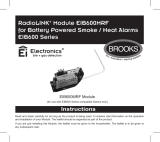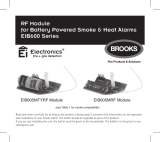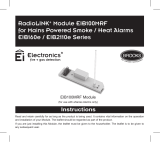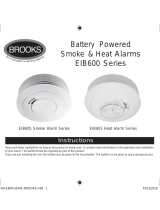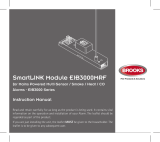Page is loading ...

Strobe Light & Vibration Pad Module
Deaf & Hearing Impaired
RadioLINK Alarm System
For use with RadioLINK Smoke/Heat/Fire Alarms
(Smoke / Heat / Fire Alarm
supplied separately)
Note: At least one RadioLINK Smoke/Fire/Heat Alarm is required to make the EIB170RFAU
Alarm operational. This is not supplied with the EIB170RFAU and must be obtained separately.
Important: Read these instructions, together with those from the separate RadioLINK Smoke/
Heat/CO Alarms and accessories before installation. All instruction leaflets must be left with the
end user after installation.
Model: EIB170RFAU

The EIB170RFAU is for use with the following Ei RadioLINK Smoke/Heat/CO Alarms and accessories.
Mains Smoke & Heat Alarms:
EIB140RC Series Alarms in conjunction with an EIB168RC RadioLINK Base.
EIB160e Series Alarms fitted with wireless module EIB100MRF.
EIB3000 Series Alarms fitted with EIB3000MRF.
Battery Powered Smoke Alarms:
EIB605 Series Alarms fitted with wireless module EIB605MTYRF or EIB605MRF
EIB650i Series Alarms fitted with EIB600MRF
Accessories:
EIB407RF Manual Call Point, EIB428RF Relay Module, EIB170RFAU Strobe Panel & EIB420RF
Repeater Module.
1. INTRODUCTION
This leaflet describes the installation of the EIB170RFAU and its integration into a total RadioLINK Fire
Alarm System, incorporating a choice of Smoke/Heat/CO Alarms and accessories.
N.B. It is essential that the EIB170RFAU is connected to the mains to preserve its one-week battery
standby. Leaving the unit operating without mains connected will completely deplete the battery and
possibly damage it. (If the EIB170RFAU is not being used for a prolonged period and cannot be left
plugged in to the mains, then disconnect the battery).
Location
The Strobe Module should normally be fixed such that the internal strobe light can be seen from the bed,
and the vibration pad can be placed under the mattress or pillow. It has to be powered from the mains
(100-240VAC/50-60Hz) so a suitable socket must be available to which it can be permanently connected.
The back-up battery in the Strobe Module must not be exposed to excessive heat such as sunshine,
heaters, fires or the like.
The associated RadioLINK Alarms and Accessories must be located and installed as described in
their own instruction leaflets.
2. INSTALLATION
Strobe Module EIB170RFAU
The battery must first be installed in the Strobe Module. Open the rear compartment by squeezing
together the two latches as shown in Figure 1b, and lifting the cover off.
Plug the battery into the socket at the
rear of the battery compartment as shown in Figure 2 (while holding the small latch on the battery
Squeeze
Here
Squeeze
Here
Battery
Cover
Figure 1b
Squeeze as shown to open
battery compartment
Auxiliary
Sockets
Vibration Pad
Primary
Mounting
Screw
Holes
Wire
Channels
for mains lead &
Vibration Pad
(and accessories
if required)
Model: Ei170
R
For use with Smoke Alarms
Fire Alarm Panel for
Deaf & Hard of Hearing
1.
Connect battery plug & then plug in mains.
2.
After installation, house code system by pressing
house code switch with a small screwdriver or simil
a
Figure 1a
2

plug, open). Place the battery in the compartment ensuring the notch in the battery is used to leave
clearance for the plug and sockets (see Figure 3).
The Strobe Module can be left on a table or permanently fixed to the wall using the screws and plastic
plugs enclosed. Use the drilling template (Figure 5) on page 9.
If fixing to a wall, the screws should be spaced 95mm (3.7 inches) horizontally apart. The top screws
will be 70mm (2.7 inches) below the top surface of the Strobe Module when installed. The template at
the end of this leaflet can be used to locate the screws accurately. The screws (large heads) should be
screwed into the wall leaving a gap of approximately 4mm (0.15in) under the head. Fit the keyhole slots
on the back of the Strobe Module over the screw heads and slide the panel down vertically into position.
The mains adaptor should then be plugged into a socket. This mains socket must not be used for any other
equipment and it must not be switched off. The mains plug must be readily removable (so the mains can
be disconnected if necessary). Note: The unit must not be wired directly to a mains junction box.
Battery
Battery
Plug
Latch
Figure 2
Battery
Clearance
Notch
Figure 3
Shows battery orientation - Dress the battery leads as shown, replace the battery cover and
push firmly down on the two latches
3

Vibration Pad EIB174
The primary vibration pad is supplied already plugged into its locking socket on the rear of the
EIB170RFAU Strobe Module (see Figure 1a). Place the vibration pad under the pillow or mattress. It
is important that the person in the bed can feel the vibration – check it is sufficient to wake a person by
lying on the bed and pressing the test button on the Strobe Module – see also Section 4, Testing and
Maintaining your System. Some mattresses may not transmit sufficient vibration, and in these cases it
should be fitted under the pillow. Note: During testing, or in an actual alarm situation, the pad pulses
on and off for greater effect on sleepers.
The Strobe Module must not be exposed to dripping or splashing and items filled with liquids such as
vases must not be placed on or above the apparatus.
3. SETTING UP THE RadioLINK SYSTEM
This system uses radio to communicate between the Fire Alarms, Accessories and the Strobe Module.
It is set-up simply by putting all of the units into “House Code Mode” and letting them automatically
code with each other. This will “House Code” the installation so that they will not accidentally signal
to, or be affected by, nearby systems.
The units will all communicate with each other (providing they are within range), as delivered i.e.
without any House Coding - however it is recommended that they are House Coded as follows:
3.1.1 Install & power all the elements of the system.
3.1.2 Press the House Code switch on all units – see individual instruction leaflets for switch locations.
On the Strobe Module, the House Code switch is pressed by means of small screwdriver (or similar,
diameter of top less than 3mm), through the access hole on the top of the unit – see figure 4.
4
Mains
Indicator
Green
(mains
disconnected =
amber flash/
4 seconds)
RadioLINK
Signalling
Blue
Clock Input
(if required)
House Code
Switch
Alarm
Red
Fault
Indicator
Amber
Test
Button
Strobe
TEST
ALARM
FAUL
T
BROOKS
Figure 4

3.1.3 Press and hold the Strobe Module House Code button until the blue RadioLINK light comes on.
Release it and the light will flash every five seconds.
3.1.4 When all units are set into ‘House Code Mode’ they should signal to each other and set-up their
network automatically.
3.1.5 Each unit will now flash its blue or amber light to show how many units it is RadioLINKED with. If
the Strobe Module is linked to just one smoke alarm they will both flash twice. With 6 units for example, 4
Smoke Alarms, a Remote Control and the Strobe Module itself, each unit will flash six times (apart from the
Remote Control, which does not have this feature). A maximum of twelve RF units can be linked this way.
3.1.6 If some units flash less than the expected number of times, after being in House Code Mode for
over 10 minutes) (say four times on a six unit system) they are out of range of each other.
Follow the advice in the RadioLINK instructions supplied with the other alarms to resolve this.
3.1.7 The units will automatically exit the House Code Mode after 30 minutes. However we recommend
that you manually exit the House Code Mode by pressing and holding the House Code switch on the
Strobe Module until the blue light turns on, then release. The blue light should stop flashing and an
‘exit House Code Mode’ radio signal will be sent to all other units. Check that the amber/blue lights
on all other units have stopped flashing. (if some units are still flashing it may indicate a problem with
the radio communication to this unit, or that the particular RadioLINK unit (model EIB407RF) does not
have this automatic cancel House Code Mode feature and must be taken out of House Code Mode
manually. Check instruction leaflet supplied with the units. Manually exiting the House Code Mode
reduces the risk of accidentally House Coding your RadioLINK Bases with nearby systems.
Note: When the blue or amber light has stopped flashing on a unit it is out of House Code Mode – do
not press the House Code switch again as this will put it back into House Code Mode.
3.2 ADDING UNITS
To add units to the system simply repeat the above procedure, i.e. put all into House Code Mode, new
as well as old units, and ensure that the number of flashes shown equals the number of units in the
system. For the other RadioLINK components see their instruction leaflets.
3.3 RESETTING HOUSE CODES
Sometimes it is necessary to cancel the House Code learned i.e. to reset the units to the factory
settings. To reset the Strobe Module to clear the House Codes, simply hold the House Code button
until the blue light illuminates solidly, then starts to flash and then stops flashing, then release
the button, this will take about six seconds. For other RadioLINK components see their separate
instruction leaflets.
5

4. TESTING AND MAINTAINING YOUR SYSTEM
4.1 AFTER INSTALLATION
4.1.1 Check that all RadioLINK Alarms and Accessories are powered correctly.
4.1.2 Check that the green light on the EIB170RFAU Strobe Module is continuously lit.
4.1.3 Press the test button on all RadioLINKED Smoke/Heat/CO Alarms, Remote Controls and
Manual Call Points in turn, and check that all other Smoke/Heat/CO Alarms in the system alarm
after about 4 seconds and that the strobe and vibration pad activate. Also check that the RadioLINK
accessories were operated.
N.B. Wait 12 seconds before testing the next unit or if you wish to repeat testing.
4.1.4 Press the Strobe Module test button. Check the vibration pad pulses, the strobe flashes and the
red alarm light on the Strobe Module flashes (this will also cause the Smoke/Heat/CO Alarms to sound
and also their red lights to flash rapidly).
4.2 DAILY & WEEKLY TESTING
Check daily that the vibration pad is in its correct position under the pillow or mattress by pressing
the test button on the Strobe Module. Also check daily that the green light on the Strobe Module is on
constantly. We recommend that you test your system weekly by pressing all the smoke/heat/fire alarm
test buttons and checking that the vibration pad and strobe light operate.
Check the Strobe Module indicator lights as follows (see figure 4)
4.2.1 Green mains power should be constantly on. If it is off check that it is plugged into the mains,
that the socket is not switched off, fuses, circuit breakers etc. If the mains is off, the green light will
be off and the unit will be running on the rechargeable battery. The green light will be replaced by
an amber flash every 4 seconds to indicate battery is satisfactory. When this amber flash stops, the
battery is depleted and the mains should be reinstated (If the mains cannot be reinstated at this time,
the depleted battery should be removed, until the mains can be re-connected).
4.2.2 Press the Test button on the Strobe Module and check that the strobe flashes, the red alarm
light flashes and that the blue RadioLINK light illuminates on for about 3 seconds indicating the radio
test signal is being sent to the Smoke/Heat/CO Alarms and any accessories.
4.2.3 Check that the amber fault light is not flashing every 4 seconds. If it is check that the primary
vibration pad is connected firmly to the socket with its plug latched (see figure 1). If the primary
vibration connection is satisfactory, it is probably indicating that the battery is depleted. Connect the
unit to the mains and check after 24 hours that the amber fault light has ceased flashing.
4.3 PERIODIC TESTING OF RECHARGEABLE BATTERY
4.3.1The rechargeable battery can take up to 20 hours to charge when the unit is first powered up. It is
then maintained in a fully charged state by continuous trickle charge. In the event of a mains failure the
battery will power the system in standby for a week and then be capable of at least 4 minutes of alarm.
If the mains fails, the green light is extinguished and the amber light flashes every 4 seconds on the
Strobe Module to indicate it is on battery power. The amber light will also flash every 4 seconds if the
battery is almost depleted. Both the amber lights will go off to indicate the battery is depleted and the unit
is totally unpowered. The battery will last 5 years in normal use provided it is not exposed to extremes of
temperature for prolonged periods, or fully discharged & charged a large number of times.
We recommend that the functioning of the rechargeable battery is checked at least yearly as follows:-
4.3.2 Ensure the Strobe Module has been mains powered for at least the previous 20 hours for the
battery to charge.
4.3.3 Turn off the mains power to the unit by unplugging it or switching off the circuit at the distribution
board. Check that the green light goes off and the amber light starts to flash.
4.3.4 Press the Strobe Module test button for 20 seconds and check the strobe flashes brightly, the
pad vibrates strongly and that all the RadioLINK alarms trigger. Check that the red alarm light flashes
while the test button is pressed. (Cover the strobe light with a card to stop this dazzling you while
looking at the red light). If the red light goes off, or if the strobe is weak, or if the vibration pad is weak,
6

the battery will need to be replaced. Contact the nearest address in this leaflet for advice about getting
a replacement. The battery also needs to be replaced if it is over 5 years old (see “replace battery by”
date on side panel). To remove the battery reverse the instructions in the first part of section 2. Contact
nearest address at the end of this leaflet on obtaining a replacement battery.
Replace the entire Strobe Module after 10 years operation. (see “replace unit by” date on side panel).
5. TROUBLESHOOTING
If the units fail any of the above tests after installation, the system has probably been incorrectly
installed and/or all units are not House Coded correctly. Check carefully that all units are powered. If
the power lights on any of the mains units are not on constantly, or flashing once every 45 seconds
on battery powered units, check the connections to the mains and/or the connections to the batteries.
(See individual unit instruction leaflets if necessary). For mains units check that the power is not off
(i.e. due to a tripped circuit breaker or fuse).
The wiring to the primary vibration pad is monitored and if the vibration pad is removed or if its wiring is
open circuit, the strobe and the amber fault light will flash (this may take up to approximately 45 seconds).
There are no user serviceable parts in this unit (apart from the battery). If the unit (apart from the
battery) is thought to be defective, it must be returned to the nearest address at the end of this leaflet
for repair or replacement (see “Five Year Guarantee” section).
Some troubleshooting items (including RF links) are specific to individual units and may not be
covered in this leaflet. In these cases the more comprehensive unit leaflet should be consulted.
6. OTHER FEATURES & ACCESSORIES
OTHER FEATURES
Strobe & Vibration Pad Module - Auxiliary Outputs - AUX 1 & AUX 2: The two auxiliary outputs
are activated when the Strobe Module is in alarm. The Aux 1 & 2 socket can supply up to 180mA at
12 Volts.
N.B. The AUX 2 socket can be used for low power devices such as pager trigger inputs.
Note: As supplied the two auxiliary sockets AUX. 1 and AUX. 2 are protected by latched plastic plugs
which must be removed before the auxiliary devices can be plugged in (see figure 5). These plugs can
be removed by pressing the latch lever (on the side nearest the “AUX” marking) before gently pulling the
plug off.
“Clock Input” Socket: A suitable alarm clock signal (with a 5 to 24 Volts AC or DC output –
electrically isolated from the mains supply) can be connected to this input socket with a 3.5mm mono
jack plug. (see figure 4) When the alarm clock triggers, the vibration pad turns on continuously (i.e. it
is not pulsed) to wake the person, but the internal strobe or auxiliary outputs are not activated. This
lets the user know it is a wake-up call and not a fire. Therefore the user needs only one vibration pad
under their pillow or mattress – rather than two, one for the Fire Alarm and one for the alarm clock.
ACCESSORIES
EIB171RFAU - Auxiliary Strobe: (draws 180mA). Supplied with 10m of cable and a suitable plug for
connection to the auxiliary socket. It should be plugged into AUX 1. It can be located, for example,
where it is readily seen during the day (e.g. downstairs hallway).
EIB174 - Auxiliary Vibration Pad: (draws 120mA). Supplied with 5m of cable and a suitable plug for
connecting to the auxiliary socket. It should be plugged into AUX 1.
EIB450 / EIB411 – Both Remote Control Units allow you to Test, Hush or Locate suitable RadioLINK
Smoke/Heat/CO Alarms.
EIB407RF - RadioLINK Manual Call Point: This allows remote triggering of RadioLINK alarms
/ accessories and is ideal where emergency situations are identified and which require immediate
evacuation.
EIB420RF - RadioLINK Repeater Module: This module can improve the robustness and range of
the RF RadioLINK signal.
7

EIB428RF - RadioLINK Relay Module: This module contains a set of relay contacts that switch upon
receipt of an alarm signal from suitable RadioLINK Smoke/Fire/Heat Alarms.
EIB171RFAU: An additional RadioLINK Strobe Module, without a vibration pad (i.e. Strobe only) is
available for use in a day rooms etc. to give a visual fire warning.It is supplied with a blanking plug,
without a cable attached, which connects into the primary vibration pad socket (marked “PAD”) to
prevent the amber fault light and strobe activating, indicating a fault (which would occur if the socket
was left empty).
5. FIVE YEAR GUARANTEE
Brooks guarantees this device for five years from the date of purchase against any defects that are due
to faulty materials or workmanship. This guarantee only applies to normal conditions of use and service,
and does not include damage resulting from accident, neglect, misuse, unauthorised dismantling, or
contamination howsoever caused. This guarantee excludes incidental and consequential damage. If
this device should become defective within the guarantee period, it must be returned to the nearest
address given below, carefully packaged, with the problem clearly stated along with proof of the date
of purchase. We shall at our discretion repair or replace the faulty unit.
8

9
Template for Mounting Screws
Drill Holes Here
12V
180mA(max)
Aux1
12V
20mA(max)
Aux2
PAD
Primary
Vibration Pad
Remove
protection
plug before
connecting
accessories
Figure 5

10
INDICATOR SUMMARY
Mode
Standby
-
MAINS / STANDBY
Green Light
ALARM
Red Light
FAULT
Amber Light
STROBE
Light
VIBRATION
Pad
RADIOLINK
Blue Light
Aux1
Aux2Amber Light
Mains on
on off
on off
__ __ __ ____ __
off1 flash / 5 sec
1 flash / 2 sec 40 flashes / min
40 flashes / min
2 sec on/off pulse
2 sec on/off pulse
on
on
__ __ __ ____ __
off1 flash / 5 sec
__
1 flash / 5 sec
1 flash / 5 sec
1 flash / 5 sec
__ ____ __
offoff offoff offoff offoff
Mains off, battery connected
Mains off, battery virtually depleted
Mains off, battery fully depleted
Sensing Fire
-
Fire signal received from smoke
Alarm
____ __ __
T
est Mode
-
Te
st button pressed on deaf alar
m
1 flash / 2 sec
______ __
40 flashes / min on for 4 sec
flashes
2 sec on/off pulse
on
1 flash / 2 sec
______
Te
st button pressed on smoke alar
m
Fault Mode
-
V
ibration Pad disconnecte
d
40 flashes / min
on
__ ____
__ __ ______
____
Battery disconnected (mains on)
House Code Mode for RF
-
Press button - enter house code
__ ____ ____ ____
flashes
__ ____ ____ ____
In house code mode
offoffon continuous
Alarm clock Input
-
Alarm input on
__ __ __ ____
on for 4 sec
__ ____ ____ ____
Press button - cancel house code

11
Mains
Indicator
Green
(mains
disconnected =
amber flash/
4 seconds)
RadioLINK
Signalling
Blue
Control Panel Indicators
Alarm
Red
Fault
Indicator
Amber
Strobe
TEST
ALARM
FAUL
T
INDICATOR SUMMARY
BROOKS

12
© Brooks 2018
P/N B19339 Rev0
NSW - Head Office
4 Pike Street Rydalmere NSW 2116
Ph: 02 9684 1466
Fax: 02 9684 4146
Website: www.brooks.com.au
VIC
1/3 Molan Street, Ringwood, VIC 3134
Ph: 03 9879 5294
Fax: 03 9879 5249
SA
729A Port Road, Woodville, SA 5011
Ph: 08 8347 0000
Fax: 08 8347 0600
QLD
2/49 Boyland Ave Coopers Plains, QLD 4108
Ph: 07 3373 8222
Fax: 07 3373 8022
WA
6/91 Leach Highway, Kewdale, WA
Ph: 08 6262 8095
Fax: 02 9684 4146
New Zealand
Unit 106 “The Zone” 23 Edwin St, Mt Eden, Auckland 1024
Ph: +64 9 638 4644, Toll Free 0800 220 007 (NZ only)
Fax: +64 9 638 4645
Or National Australian Sales Number: 1300 78 FIRE (3473)
For the cost of local call.
/

